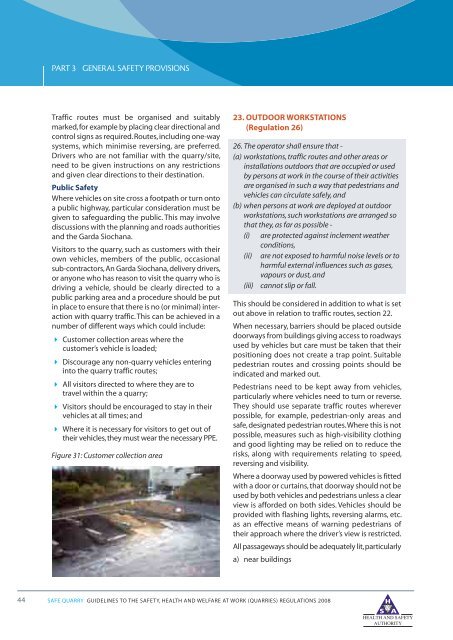Safe Quarry - Health and Safety Authority
Safe Quarry - Health and Safety Authority
Safe Quarry - Health and Safety Authority
You also want an ePaper? Increase the reach of your titles
YUMPU automatically turns print PDFs into web optimized ePapers that Google loves.
PART 3<br />
GENERAL SAFETY PROVISIONS<br />
Traffic routes must be organised <strong>and</strong> suitably<br />
marked,for example by placing clear directional <strong>and</strong><br />
control signs as required.Routes, including one-way<br />
systems, which minimise reversing, are preferred.<br />
Drivers who are not familiar with the quarry/site,<br />
need to be given instructions on any restrictions<br />
<strong>and</strong> given clear directions to their destination.<br />
Public <strong>Safe</strong>ty<br />
Where vehicles on site cross a footpath or turn onto<br />
a public highway, particular consideration must be<br />
given to safeguarding the public. This may involve<br />
discussions with the planning <strong>and</strong> roads authorities<br />
<strong>and</strong> the Garda Siochana.<br />
Visitors to the quarry, such as customers with their<br />
own vehicles, members of the public, occasional<br />
sub-contractors,An Garda Siochana,delivery drivers,<br />
or anyone who has reason to visit the quarry who is<br />
driving a vehicle, should be clearly directed to a<br />
public parking area <strong>and</strong> a procedure should be put<br />
in place to ensure that there is no (or minimal) interaction<br />
with quarry traffic. This can be achieved in a<br />
number of different ways which could include:<br />
Customer collection areas where the<br />
customer’s vehicle is loaded;<br />
Discourage any non-quarry vehicles entering<br />
into the quarry traffic routes;<br />
All visitors directed to where they are to<br />
travel within the a quarry;<br />
Visitors should be encouraged to stay in their<br />
vehicles at all times; <strong>and</strong><br />
Where it is necessary for visitors to get out of<br />
their vehicles, they must wear the necessary PPE.<br />
Figure 31: Customer collection area<br />
23. OUTDOOR WORKSTATIONS<br />
(Regulation 26)<br />
26. The operator shall ensure that -<br />
(a) workstations, traffic routes <strong>and</strong> other areas or<br />
installations outdoors that are occupied or used<br />
by persons at work in the course of their activities<br />
are organised in such a way that pedestrians <strong>and</strong><br />
vehicles can circulate safely, <strong>and</strong><br />
(b) when persons at work are deployed at outdoor<br />
workstations, such workstations are arranged so<br />
that they, as far as possible -<br />
(i) are protected against inclement weather<br />
conditions,<br />
(ii) are not exposed to harmful noise levels or to<br />
harmful external influences such as gases,<br />
vapours or dust, <strong>and</strong><br />
(iii) cannot slip or fall.<br />
This should be considered in addition to what is set<br />
out above in relation to traffic routes, section 22.<br />
When necessary, barriers should be placed outside<br />
doorways from buildings giving access to roadways<br />
used by vehicles but care must be taken that their<br />
positioning does not create a trap point. Suitable<br />
pedestrian routes <strong>and</strong> crossing points should be<br />
indicated <strong>and</strong> marked out.<br />
Pedestrians need to be kept away from vehicles,<br />
particularly where vehicles need to turn or reverse.<br />
They should use separate traffic routes wherever<br />
possible, for example, pedestrian-only areas <strong>and</strong><br />
safe, designated pedestrian routes.Where this is not<br />
possible, measures such as high-visibility clothing<br />
<strong>and</strong> good lighting may be relied on to reduce the<br />
risks, along with requirements relating to speed,<br />
reversing <strong>and</strong> visibility.<br />
Where a doorway used by powered vehicles is fitted<br />
with a door or curtains, that doorway should not be<br />
used by both vehicles <strong>and</strong> pedestrians unless a clear<br />
view is afforded on both sides. Vehicles should be<br />
provided with flashing lights, reversing alarms, etc.<br />
as an effective means of warning pedestrians of<br />
their approach where the driver’s view is restricted.<br />
All passageways should be adequately lit,particularly<br />
a) near buildings<br />
44<br />
SAFE QUARRY GUIDELINES TO THE SAFETY, HEALTH AND WELFARE AT WORK (QUARRIES) REGULATIONS 2008
















